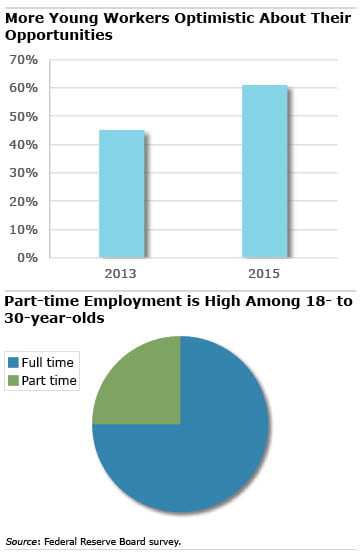
Young Workers’ Hopes Confront Reality
 As the post-recession job market continues to improve, so has young adults’ optimism about their future opportunities, a Federal Reserve Board survey shows.
As the post-recession job market continues to improve, so has young adults’ optimism about their future opportunities, a Federal Reserve Board survey shows.
What’s poignant about this youthful optimism is that a changing labor market is making it increasingly difficult for young adults to get their careers off to the right start.
Surely, they sense this. Nearly two-thirds of adults between ages 18 and 30 told the Federal Reserve in a 2015 survey featured in a recent webinar that their schedules in “permanent” jobs were changing daily, weekly, or monthly. They strongly prefer future job stability over higher pay, despite the trendy flexibility of the “gig” economy, Uber driving, and freelancing.
“Permanent employment is not the same as stable employment,” Amy Blair, the Aspen Institute research director for the economic opportunities program, said during the webinar. “Without a stable floor, it’s difficult for a person to invest in himself or herself to build a career.”
The U.S. Bureau of Labor Statistics (BLS) has identified 30 jobs it predicts will have the fastest growth, generating 5 million jobs by 2024. Most of the top 10 are characterized by part-time, low-paying, or seasonal work that can make it difficult to put together a full-time schedule, Blair said. Many are the types of jobs that also lack health benefits, 401(k)s, and paid-time off.
The BLS’ top 10 are:
- personal care aides, home health aides, food preparation and servers, nursing assistants, cooks, and retail salespeople (average annual earnings below $30,000);
- customer service representatives and construction laborers ($30,000-$40,000);
- registered nurses and operations managers (over $60,000).
While optimism tends to be higher among more educated young adults, borrowing money to finance an education can create a large financial burden many aren’t preparing for. Investments in higher education are especially “risky” for people facing uncertain career paths, said Heidi Kaplan, an analyst with the Federal Reserve, which sponsored the webinar to discuss the bank’s report, “Experiences and Perspectives of Young Workers.”
 Kaplan also noted that too few young adults with some post-secondary education – about 45 percent – reported getting jobs in their field. Unemployment overall is higher and labor force participation is lower for 20- to 34-year-olds than it is for older workers.
Kaplan also noted that too few young adults with some post-secondary education – about 45 percent – reported getting jobs in their field. Unemployment overall is higher and labor force participation is lower for 20- to 34-year-olds than it is for older workers.
A bright spot is so-called STEM jobs – in the science, technology, engineering, and mathematics fields. Two-thirds of young adults who studied these areas are getting jobs in this field, which had the highest pay in the BLS’ fast-growing occupations. (The success rate is less for graduates in the life sciences, business, health, and behavioral science fields.)
One problem in the STEM field is that women and people of color are under-represented, said Ofronama Biu, senior research associate for the New York City Labor Market Information Service at City University of New York. While the share of young women entering STEM fields is increasing, they typically earn just $58,800 per year, compared with $88,500 for their male colleagues. Black men and women earn about $75,000.
Kaplan pointed to one hopeful finding: young adults with non-college certificates or technical degrees are more often getting jobs in their fields than people with associate’s degrees, and do nearly as well as graduates with bachelor’s degrees.
Given the labor market outlook, employment experts stressed in the webinar that the education that young adults receive should better align with the job opportunities available to them – and labor and education policies should aim to achieve that goal.
“Perhaps we need to think about the value of successful certificate programs,” Kaplan said.
Squared Away writer Kim Blanton invites you to follow us on Twitter @SquaredAwayBC. To stay current on our blog, please join our free email list. You’ll receive just one email each week – with links to the two new posts for that week – when you sign up here.
Comments are closed.







Very interesting that graduates from the technical schools are seeing higher job placement than associate holders. Proof that the need for specialized training/education is more important than ever?
Jordan @ New Retirement
Exactly, I agree with this point that permanent employment is not the same as stable employment. Every young adults might get a job, but the success rate is not reaching to the mark. Because, as you said, people who are graduates of engineering, technology, etc. can get jobs in the same field. And no one is looking for business, health sciences graduates. If these graduates can also get jobs in their field then the growth will automatically increase.
For decades European economies have recognized the importance of training in the trades and technical fields and have endeavored to sort students into appropriate career paths in early secondary school. Yet in this country, we still insist in channeling our young people toward college enrollment even when they may be suited to a different career path. Hence, the high numbers of college drop outs and unemployed/underemployed college graduates.